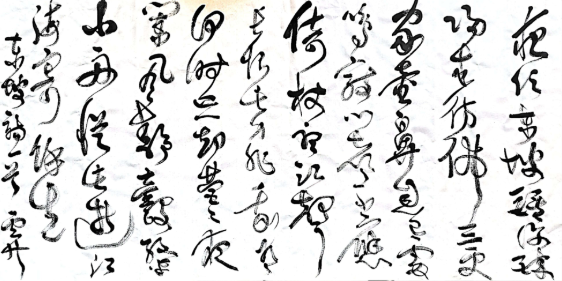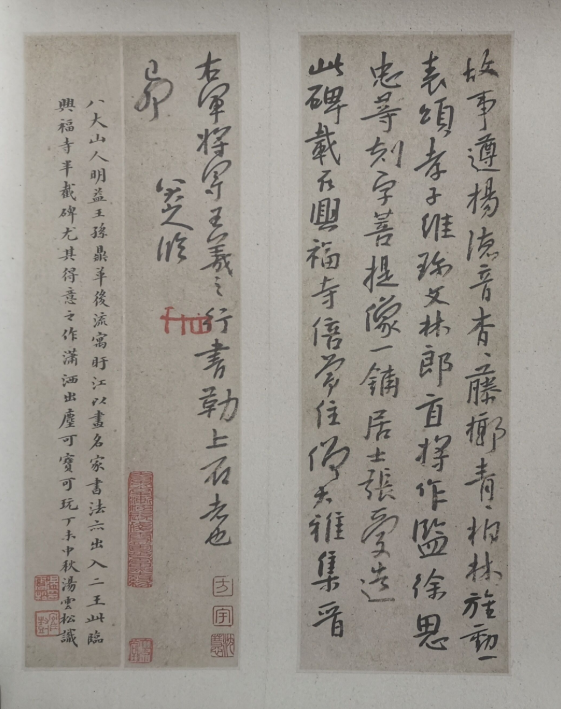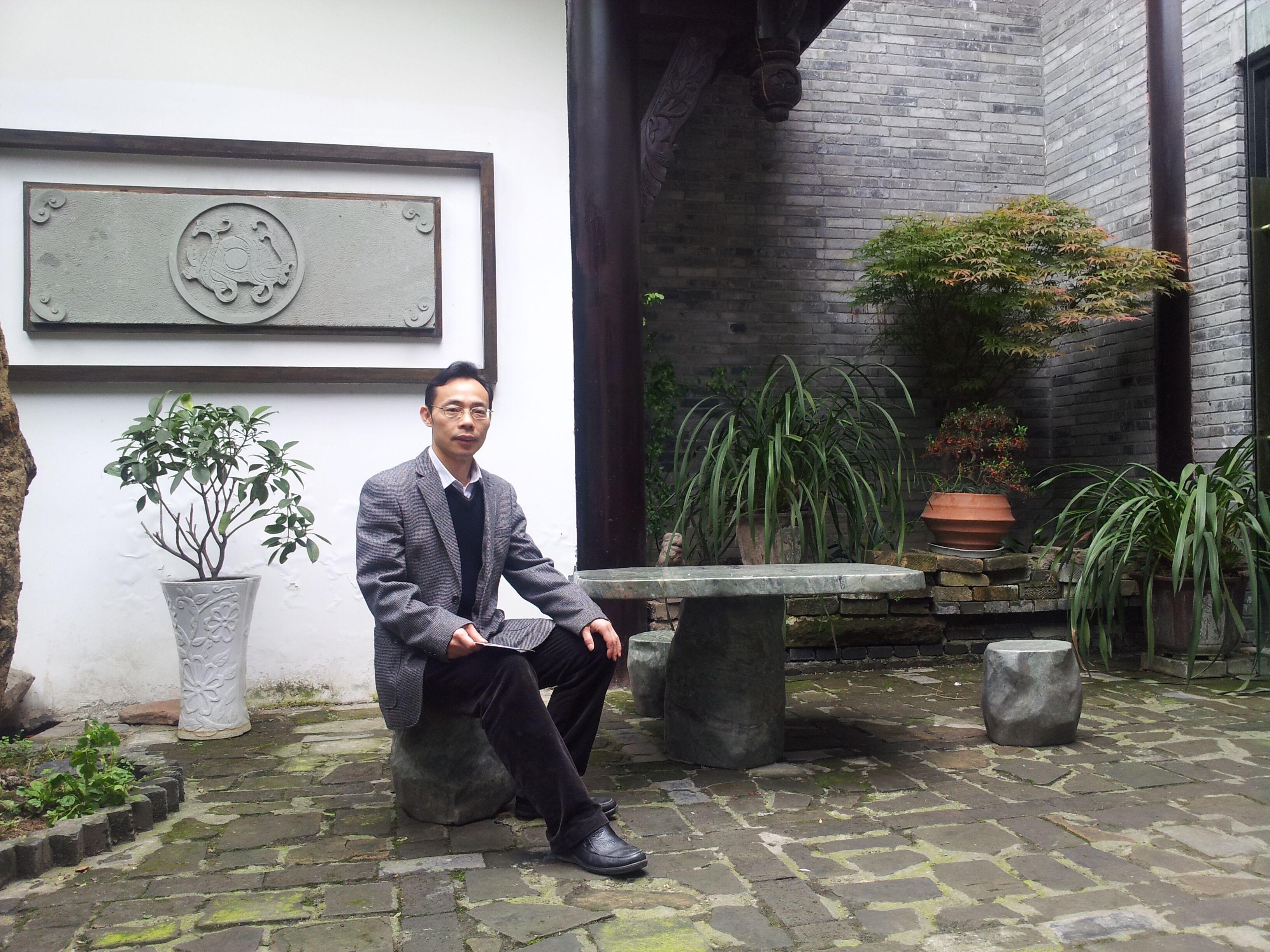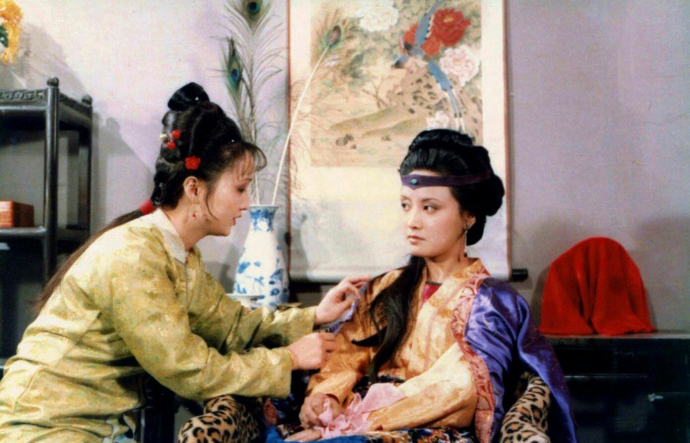Video | The old student who came out of Zeng Gongli Lane -the light ink life of the calligrapher Rao Zhenhua
Author:Jiangnan Metropolis Daily Time:2022.09.19
Jiangnan Metropolis Daily News reporter Duan Ping reported: Single -footer exceeded 30,000 yuan, and single -piece calligraphy works set a record of 600,000 yuan ... In recent years, the art market is sluggish, but Tao Bowu's calligraphy works are on the shooting field in Jiangxi frequently. make a record. Rao Zhenhua, his disciple, believes that Tao Lao's poetry, calligraphy and painting art is increasingly favored and favored by contemporary. It is a highly integrated with the art and life of the old gentleman. Rao Zhenhua was less than 20 years old with the great literati calligraphy and painter Tao Bowu, who came into the teacher because of the fate, and came from Shuxiangmen Di from him. He loved calligraphy. In the past 40 years, he studied art hard and insisted that calligraphy was naturally revealed and unified from the inside out. The creators must work hard on personal knowledge and cultivation in order to write poetry and writing that moved people's hearts.

Cursive Su Shi Shi Lin Lin "Jiangxian -Night Drink Dongpo Wake up and Drunk".
Therefore, the land and Jiayuan, sow the seeds of art
East of Gannan, beautiful scenery, Zhong Lingyuxiu, there are thousands of years of ancient city of ancient cities, ancient talents Zeng Gong, Qianqiu ancient kiln porcelain, thousands of years of non -widow dance, Chitose tribute Miraza and famous. Rao Zhenhua is located in his hometown in the west of Nanfeng City. It is the old house of Sanzhong Temple in Nanfeng Song, Song, Ming and Qing Dynasties. Zeng Gong's reading rock on the banks of the River. This allows him to have a background of life from a young age to literature and art naturally.

Qing Tang Yunsong Titles Eight Dashan people Lin Wang Xi's Xingfu Temple half (excerpts).
From his ancestors, he has a clear family learning context. According to historical records such as "The Encyclopedia of Jiangxi's Senmorus" and "Nanfeng Local Chronicle", Rao Zhenhua's ancestor Rao Yuanliang, Shi Tang Dezong, was a two -ancestor Rao Jie, the teacher of the famous poet and calligrapher Song Ke in the late Yuan and early Ming Dynasty. Rao Zhenhua's Zengwai Zu Tangfan was a well -known scholar and calligrapher. During the Qianlong period, he was a prisoner of the Ministry of Households. The two generations of Tang Fan's father and the two generations were all princes, and they went out of four Jinshi (Tang Fan and his son Tang Yunkai, Tang Yunsong, Tang Yunlin). Tang Yunsong, a jinshi of Qingdao, was the ambassador of Jiangning. In his later years, he hosted the Bailudong Academy and the Jiangjiang Academy. He was good at calligraphy. Xiao Kai was widely chanted for the book of the "Xingfu Temple" in the Eight Dashan people. When the father and son of Tang were officials, he was diligent and the people, and he was aware of the people. He had a reputation.
The strong hometown and the home style of the poems inadvertently broadcast the seeds of art on Rao Zhenhua's young hearts. With the flow of years, sprouting, rooting, flowering ... Rao Zhenhua's father was the only child, so he gave birth to 10 children, but no matter how hard he lives, his father continued the tradition of reading ancestors and insisted on asking their brothers and sisters to study hard. In memories of childhood, Rao Zhenhua said that in the enlightenment of art, encouragement and talent were equally important. He all appreciated his father's encouragement throughout his life and let him fall in love with writing. Once the Spring Festival, 5 -year -old Xiao Zhenhua got money wrapped in big red paper, and happily wrote three words on it. As a result, the father said surprisingly to his mother: "You see Zhenhua's words a little bit. Like Wang Xizhi's font! "You know, at that time he hadn't attended school. This was the first time he wrote, and he didn't know who Wang Xizhi was. He just felt praise from his parents' joy, so he was deeply encouraged to start writing.
Since then, from reading to work, calligraphy has been with him. In 1987, Rao Zhenhua won the fifth place in the first youth calligraphy competition in Jiangxi Province. The first place was Zeng Yinquan, a famous calligrapher who was also a nanfeng fellow. Rao Zhenhua was grateful that on the road of calligraphy art, it was encouraged by his father and many seniors and good teachers and friends, inspiring him to continue to innovate. For example, in 1990, he won the first prize of the calligraphy exhibition of the Jiangxi Provincial Organs. In the same year, he was invited to participate in the art calligraphy and calligraphy exhibition of art and calligraphy in the six provinces of East China, Fu Zhouhai, and Sun Qingzheng (provincial 3). In 1991, Mr. Xu Husheng, who won the first prize of the national seal engraving competition and the first prize of the New Year Painting Exhibition, had a lot of love for his cursive script, and seal the name and first seal for him. In November 2003, he won the award of calligraphy exhibition in the 110th anniversary of Comrade Mao Zedong's birthday, and was affirmed by experts such as Qi Gong. In April 2007, the "Harmony" calligraphy exhibition was held at the Nanchang Art Museum. Mr. Xu Yinong wrote the preface and attended the opening ceremony. Fate and opportunities, Tao Bowu, a master artist at the teacher
Calligraphy is a traditional art unique to China, and it is also a form of artistic expression. In ancient times, writing was an expression of literati expressed inner feelings. It was a lifestyle. The book was first literati and poetry.
Three poems of Song Wang Anshi.

Rao Zhenhua is very fortunate that he loved calligraphy since he was a child in such a living atmosphere. The old house he was born and grew up is a unique building, with two floors up and down, more than 100 square meters. Used to study and study, his father is romantic named "Reading Hall". His home has still preserved the inscription posts of great -grandfather, the horns of the horn, and the old rosewood's Duanbi. On the New Year's Eve, the family will stick the children's own and written spring couplets. The Spring Festival couplets of each door have different requirements. Rao Zhenhua started to put his own spring couplet on the wall like his sisters and brothers around the age of 10.
Regarding the interesting things of the teenager, Rao Zhenhua remembered that when he was 13 years old, his hometown was very close to the county gymnasium. He often went there with his friends to practice weightlifting there. Due to excellent grades, the weightlifting photos also put on the stylistic window of the County Sports Bureau and were recommended by the county. In the provincial sports team, it almost became a provincial team professional athlete. At that time, he came to the provincial capital from Nanfeng. "When I saw the atmosphere of the sound of the sound of the weightlifting room, I felt that it was too far from the environment that I grew up from an early age." In the end, he abandoned "abandoning the text". When he was a child, he was active. In addition to the weightlifting, he also liked to play basketball. He was very small but bouncing very high. He had the nickname of "spring legs" and "god pitcher". Later, Qiu Zhenzhong, a professor of the Central Academy of Fine Arts and a contemporary calligraphy master of Jiangxi, found that Rao Zhenhua found that the two had the same experience. Qiu Zhenzhong had a well -known gymnastics while studying in Nanchang No. 2 Middle School. At the same time, he also had talent in Peking Opera. The Peking Opera Troupe even sent a notice to the family and was stolen by Mother Qiu. The two resonated with this: the sports career has gained a lot, strong physical exercise has been exercised, and confidence has also been established, adding courage to challenge self -defeating difficulties.
One day in 1983, Rao Zhenhua ushered in a turning point in life. At the age of seventeen or eight, he came to Nanchang to study at the university. Once he went to the Provincial Literary Federation to read the Painting and Calligraphy Exhibition. He stood in front of a script to stop and watched. He came next to a 80 -year -old man with a crutch. The old man was also interested in the book of the young man, and asked him, "Do you like the book, what is the word written on it?" Rao Zhenhua replied that he had read a lot of such stereotypes at home when he was a child, so he knew the book. When the old man was happy, he immediately left the address and invited him to go home to play. At that time, Rao Zhenhua didn't know that the simple and spiritual old man in front of him was Tao Bowu. The book he admired was also the book of Tao Lao.
When the holiday, Rao Zhenhua went to the old Tao's house. Not only was he enthusiastically received, he also had to stay at his house to eat, but the young people were embarrassed and declined several times, but caused the elderly to be unhappy. Rao Zhenhua said that at that time, the people were simple and pure. When Tao Lao saw young people who liked calligraphy, he was willing to guide and inherit traditional culture to his juniors. Moving by Tao Lao's sincerity, Rao Zhenhua later became a frequent visitor to the old Tao's family. Every time he returned to Nanchang from his hometown, as long as he brought a basket of Nanfeng Midu Orange Master, the old man was very happy.
In daily life, Tao Lao likes to talk about current events. In terms of art, Rao Zhenhua should read more. It is necessary to read the ancient classic readers and understand modern scientific knowledge. Tao Laochang said: It is not difficult to write and painting, and it is difficult to read. Art must have a style, and to form excellent personality. The so -called excellent is the thick accumulation after reading the precipitation, so that it can be more deeply expressed by art and become a thoughtful artist.
Gradually cultivation and epiphany, calligraphy is the precipitation of cultivation and the externalization of the spirit
Tao Bowu's calligraphy and painting can frequently set auction records during the downturn in the art market. Rao Zhenhua believes that this seems to be unexpected to ordinary people, but it is reasonable in the industry, and there is even huge room for rise in the future. Tao Bowu is the earliest batch of scientific class students in China to learn art. From Huang Binhong, Wang Yiting, Pan Tianshou, Zhu Wenyun, He Tianjian and other learning calligraphy and painting. Its pen and ink penetrate into life experience and cultivation, full of true feelings, true and simple emotions, Rao Zhenhua's speech, "The reason why Tao Lao's works can move people is that he advocates simple and simple, from the simplicity of life to the simplicity of artistic style. This is his aesthetic orientation, and it is also the adherence to people. " Tao Bowu gave Rao Zhenhua a comprehensive influence on the pursuit of art aesthetic style and life value. Among Tao Bowu's few disciples, Rao Zhenhua is a few people who inherit the internal quality of the teacher's calligraphy. He was able to focus on learning the essence of the teacher's calligraphy, but he was not trapped by the teacher's font form, and bravely broke out a new way for himself. Rao Zhenhua believes that Chinese calligraphy is a carrier through tools such as pen and ink and paper, and expresses the trajectory of the life of the writer, the rhythm of the heartstrings, the emotional container, the precipitation of the emotion, the precipitation of the spirit, and the externalization of the spirit.
He concluded that learning and appreciation of calligraphy must first grasp the word "law". Calligraphy is the method of law. In the ancients, it is a script for script. It requires technical support. Spirit. The second is to feel the word "love". Calligraphy is expressing feelings. In history, the three major books in the world are the crystallization of emotions. Third, rising to the word "Tao", we must grasp the rules of the calligraphy, to use the way to carry the way, and a artistic and innovative development. Fourth, it is necessary to enter the word "fate", and it is organized to enter and love calligraphy.
Cursive Du Fu's poem "Ascension".
Rao Zhenhua studied calligraphy, starting from deep to the classic law posts, grasping the core things in the classics, and absorbing its essence. For example, Wang Xizhi's dignified and elegant, Li Yan's strong and strong, and the Zhenxun innocence of the rice belt experience the characteristics of typical book style and representative scholars in different historical periods. The next step is to gradually cultivate, because the traditional calligraphy art treasure house is like the vast sea. He perceives through some classic law posts that are the same as his heart and enters the inner heart. For example, Wang Xizhi's typical, richness and strong sense of lyricism, rhythm, and rhythm of calligraphy in "Lanting Preface". For example, how Yan Zhenqing innovated in inheritance and created a new model, and well interpreted a passpiring pens and the spiritual orientation of life and the spirit of pen and ink. It is the three cornerstones of his immortal calligraphy. Through the gradual understanding, Rao Zhenhua let the wisdom of these live characters projected into their minds, and constantly make their works have their wisdom shadow, not just the appearance.

Rao Zhenhua began his 20 -year -old niece manuscript and Wang Duo's cursive poems, which laid the style of book that he liked to lyrical and bold. For decades, I have been trying to follow up from Pingfu posts, championship posts, Wang Xianzhi's cursive six posts, self -narrative posts, and upper seat posts, and constantly understand what Sun Guoting's book says: cursive script is smooth and smooth, with some paintings as sexual temperament. In order to turn it into form.
"There is a three -pointer of accumulation ink, and my heart is not a little bit thick; I am not a Danqing hand, but I only live in my chest." In life, Rao Zhenhua often wrote poetry to express emotions. He remembered that Pan Tianshou once said that a good Chinese painter should be a poet in essence. "He emphasized that there must be a moving place in the work, and the expression of poetry and painting. Calligraphers should be the same because Chinese calligraphy and painting are homologous. I often read the masterpieces of masters such as Fu Baoshi. Feeling that there is a state of independence and vastness, just like a beam of light in life, it is attracted and moved in his heart. "Rao Zhenhua's calligraphy makes people clear Sales naturally. From his poems, he felt that after a long -term calligraphy practice, the paintings were accurate, the lines were severe, slow, simple, and dense, and the unique language and image brought by color, space, and rhythm.
For example, in the early winter of the 1898, he met with Mr. Wu Zhenli, who had won the Golden Award of the first young and middle -aged calligraphy exhibition in 1980 in Jinling. I don't care about the year. Such intersections, Linchi, leisure, mountain climbing, exhibition, farming, etc. As long as the strokes of his heart strings are often dialed, he also becomes a real life.
Chibi smoke and waves far away, Su Gong's name is chanting for thousands of years; the admiration does not go because of flowing water, and the teenager of Huaijin comes (in the autumn of 1998, the Chibi feels). This pavilion in Shenzhou is ancient, with a sequence of sacred names; Xiu Xun opened a new chapter, and there are traces of flowing songs; looking up at the universe, looking at the category of the category; The green is deep; Huifeng brushes the green, and the ink is in the ink; Wait for the award to feel).
Poetry and writing, book roll gas in calligraphy art
"There is a peaceful ancient name of the hometown -Jiahe; the hometown has a warm name -Nanfeng. The dance of spring is her ancient and melodious song. The orange water reflects the figure full of golden fruit, and the winter army peak stands with a smiley clouds. Oh, different seasons have her unique face and style. Stay away from Sangzi Youzi common concern and praise. There are my father and villagers in my hometown, and there are childhood partners in the alley. How many times of the new vine. The stations of life always stop and pay attention to their hometown from time to time. The hometown is hidden in my mind and restrained in my heart. " It is enough to comfort the red dust, the intestines are wide, the poetic is spring grass, and the face is far from the hustle and bustle. Forgot to float, the spring and autumn do not enter the dream, and the dream is deep.
This poem called "Hometown Xiaoyi" made Wang Jiannan, a free writer and independent art critic, lamented that in addition to falling in love with literary creation, Rao Zhenhua also implied his abstract as a scholar. The initial origin. To this end, Wang Jiannan wrote the article "The Reflection of Poetry and Writing", and explored how a poet who loved calligraphy transformed vivid literature into abstract text writing. Wang Jiannan believes that his hometown has long been a mother who seeks the authenticity in calligraphy creation, and has become an exit provided by writing as an emotional release. Grasping this "export" is an important ending point for understanding Rao Zhenhua's calligraphy characteristics. Literature's appeal is inseparable from the rich imagination of readers, and the expression of calligraphy requires lines to be carried. The "swaying" presented in Rao Zhenhua's calligraphy works is a personalized writing interpretation of the word "mother -in -law". The following are the festivals of Wang Jiannan's "Poetry and Book -Rao Zhenhua Calligraphy Art".
As a pursuit of writing, a overall goal will be set at every stage of creation. Judging from the style of Rao Zhenhua in the past ten years, after achieving the first goal "Swaying", he could not help but have some kind of loss, because even if the connotation of these four words was fully expressed, it was not China. The highest level of calligraphy, the next step needs to weaken this over -prominent pens preference, and develop towards a higher level- "idle and free". It is not enough to achieve this state of mind alone. The so -called "Kung Fu is outside poetry", creators must work hard on personal knowledge and cultivation to improve their personal temperament. At the same time, combined with the mood when writing, it is possible to find the balance point of the writer's unique temperament between the survival state and feelings.

Rao Zhenhua knew like this and went to explore this way. So I glanced at his new breakthrough. Su Shi, written in 2022, reflects this kind of book gas. Book roll gas refers to the relaxation, fluent, vigorous, and dexterous form of the latch in ancient poetry, simplified ink, and engraving. If Jin Shiqi reflects a kind of vigor and clumsy, then the book roll gas reflects an elegance.
Rao Zhenhua's "Linjiangxian · Night Drinking Dongpo Wake up and Drunk Drunk" shows a kind of persistence from the vertical and horizontal. Expressing. When Su Shi wrote this word, he was at the lowest point of his career, but it was the most literary time in his life. He lived in Huangzhou and wrote the most Chinese chapter in his life. "Linjiangxian · Ye drink Dongpo Wake -up Drunk" is one of them. Rao Zhenhua specifically selected this East Poor word as the main goal of training. In addition to the respect of Su Shi, there is also a pursuit of scrolls. When the content of writing is highly consistent with the skill of writing, the writer may climb on a new peak of art.
As a result, let's review the calligraphy aesthetic experience brought by Rao Zhenhua to the viewer. From the "swaying and versatile" that emphasizes the personality of life to the "idleness" of convergence of self, to the self -reshaping of "majestic and simple", it always reaches the other side of the book. He wrote his soul through writing, converting the trajectory of life growth into different calligraphy images of calligraphy, and cast a high spiritual weather in the accumulated aesthetic taste.
Introduction to Rao Zhenhua:
Born in April 1966, the former vice chairman of the Tao Bowu Art Research Association, director of the Jiangxi Calligraphers Association, director of the Academic Committee of Jiangxi Provincial Book Association, a special calligrapher of the Ganjin and Ministry of Painting Court, the work was successively by the Wu Daozi Art Museum, Zeng Gong Memorial Hall, and the Memorial Hall, and the Memorial Museum of Memorial Hall, The Li Shizhen Museum and other units and people at home and abroad have won awards in important calligraphy competitions across the country, provinces and cities, and published papers in academic journals and newspapers such as "Chinese Calligraphy", "Calligraphy and Calligraphy World", "Jiangxi Daily". International Cultural Publishing Company published the "Chinese Powerful Calligraphers for Rao Zhenhua's Works".
Editor on duty: Zhou Zhangyun

Duty review: Jinlu Yao
Editor -in -chief: Huang Lianwen
- END -
The 7th "Creative Jining" cultural product design and the first "Confucius Cultural Tourism Cup" hand -made contest ended
Jining News Network (correspondent Zhang Ge) On August 13, the seventh Creative Jining cultural product design and the first Confucius Cultural Tourism Cup hand -made contest awards ceremony was h
Ping'er, my difficulties, no one can experience it

Baoyu Wei served Ping'er's makeup. He was full of sympathy and compassion for Ping...